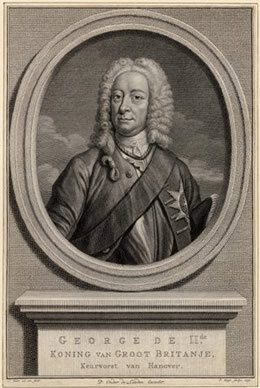RICCARDO PRIMO (HWV 23)
Libretto: Paolo Antonio Rolli, after Francesco Briani
First performance: 11th November 1727, King's Theatre, London
Cast
- Francesco Bernardi, called "Senesino" (Alto-castrato)
- Francesca Cuzzoni (Soprano)
- Faustina Bordoni (Soprano)
- Antonio Baldi (Alto-castrato)
- Giovanni Battista Palmerini (Bass)
- Giuseppe Maria Boschi (Bass)

Synopsis
Act I
A storm off the coast of Cyprus sinks the English fleet with which Riccardo Primo (alias Richard the Lion-Hearted) wished to fetch home his beloved Princess Costanza of Navarre. Believing her fiancé to have drowned, the disconsolate Costanza and her manservant Berardo assume false names and seek shelter at the court of the villain Isacio. Isacio is enthralled by Costanza’s beauty and begins to woo her affections. But Riccardo has survived. Disguised as his own emissary, he confronts Isacio and demands that he releases Costanza, whom he has never seen. Isacio promises to release his fiancé.
Act II
Berardo promises Costanza to find out whether Riccardo knows that she is still alive. The wily Isacio learns of Costanza’s true identity and orders his daughter Pulcheria to disguise herself as Costanza and marry Riccardo. Pulcheria, distraught, promises to herself that she will unveil the subterfuge at the next opportunity. Isacio’s deceit is exposed, and Pulcheria offers herself as a hostage in order to free Costanza. Only at the end of this broadly conceived second act do Riccardo and Costanza meet for the first time and, in a beautiful duet, swear eternal love.
Act III
Costanza’s repatriation misfires at first as Isacio ambushes the couple with a deft manoeuvre. Tearing Costanza from Riccardo’s arms, he takes her captive. Costanza, in the palace, begs for death as her only release and beseeches heaven for assistance. Isacio, with Costanza as his hostage, sets out against Riccardo’s onrushing forces. As he prepares to attack, Oronte intervenes and disarms him. Finally, after a battle symphony with trumpets, horns and timpani, Riccardo triumphs over Isacio’s forces. A triumphal march ensues, and Riccardo pledges eternal fidelity to Costanza and his friendship to Pulcheria. All join together in a chorus of jubilation.
Context
The premiere of Giovanni Bonocini’s Astianatte was delayed twice because of the illness first of Faustina and then Cuzzoni. When it finally appeared on 6th May 1727, the two women were back on stage together, although the opinion was that Cuzzoni’s voice was still not fully recovered. A month later, on Tuesday 6th June the rivalry between their supporters in the audience finally errupted in full-scale war. The ‘British Journal’ of 10th June was to report:
On Tuesday-night last, a great disturbance happened at the Opera, occasioned by the Partisans of the Two Celebrated Rival Ladies, Cuzzoni and Faustina. The Contention at first was only carried on by Hissing on one side, and Clapping on the other; but proceeded at length to Catcalls, and other great Indecencies: And notwithstanding the Princess Caroline was present, no Regards were of force to restrain the Rudeness of the Opponents.
Although such outbursts were becoming more common, and had even happened during a performance of Handel’s Admeto when Princess Amelia was present, such outrageous behaviour in the presence of the Princess of Wales could not be tolerated. The performance was abandoned, as the singers jumped from the second act finale to the final chorus, and the theatre was closed for the next few days to allow both parties to calm down.
Within days satirical pamphlets were produced lampooning the opera scandal. The most popular of these, The Devil To Pay at St. James’s: Or, A Full And True Account Of A Most Horrible And Bloody Battle Between Madam Faustina And Madam Cuzzoni, Etc. dramatised in rhyming couplets an onstage battle between the two singers, giving rise to the belief that they had in fact come to blows on stage. It is clear from contemporary newspaper reports, however, that the ‘contention’ was confined to their fans.
Whether or not the Royal Academy of Music intended to re-open the opera we do not know, for within a week of this outburst on 11th June, King George I died of a stroke while visiting his home in Germany. All theatres and other places of public entertainment were closed as a mark of respect.
Handel had already prepared the score of Riccardo Primo in May 1727, perhaps as the final piece for the Royal Academy’s current season. It seems that Handel himself suggested the Francesco Briani libretto to Rolli as one he would like to set. It was the only time in his operatic career that he chose a subject from British history, and it is tempting to speculate that his recent naturalisation had prompted his choice. But with the closing of the theatres, the work was shelved for the time being.
In the meantime, Handel received a commission in August to compose the music for the coronation of King George II which was to take place on 11th October 1727. The Four Coronation Anthems received their premiere on this day, the first of which, Zadok the Priest, has been performed at every British coronation since.
The pervasive feeling of patriotism evoked by the coronation was reflected in Handel’s re-working of Riccardo Primo as he prepared it for performance in November. There were voices to be recast as some of his singers had left the company since the work had been written in May, and Handel did his best to ensure that the roles of Costanza and Pulcheria were evenly distributed between his leading ladies. Despite all this the work was not a great success and Handel never revived it. He did, however, use it as a source for revivals of other works, using no less than 13 arias from Riccardo Primo in 8 subsequent productions.


